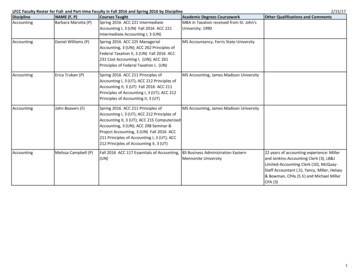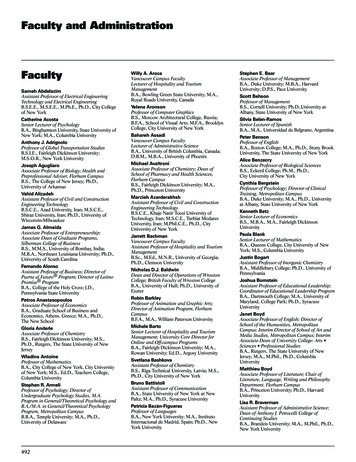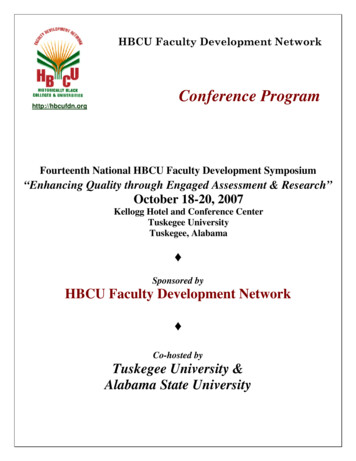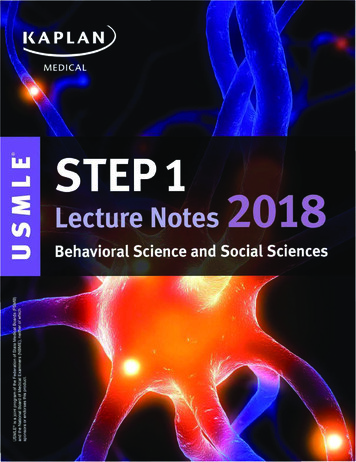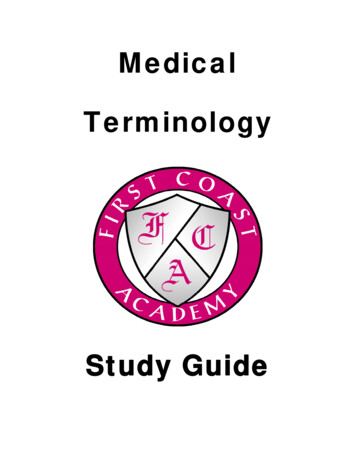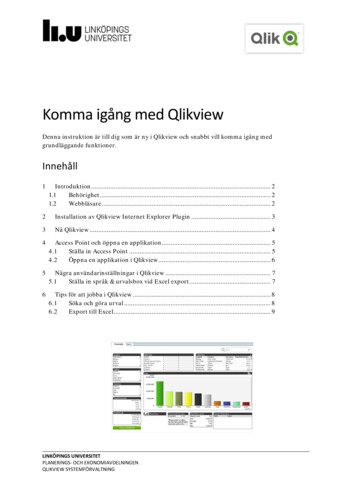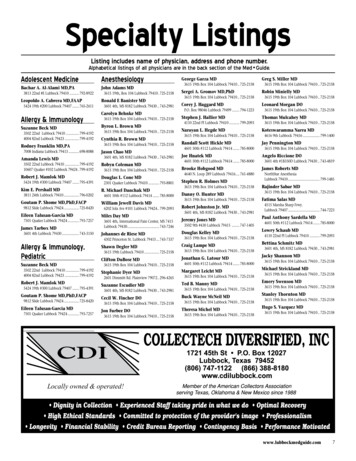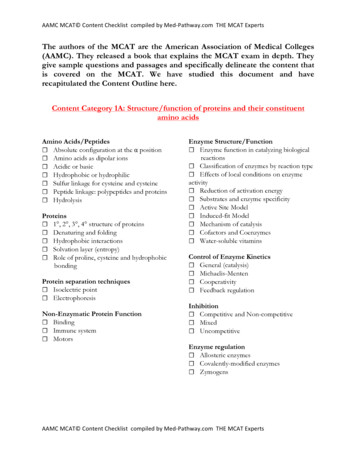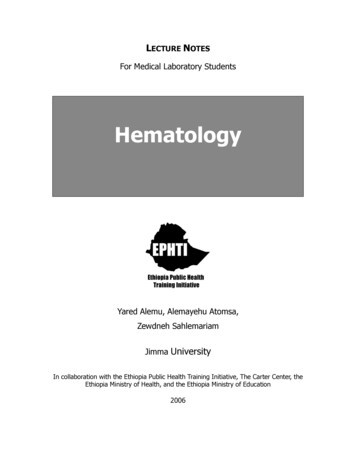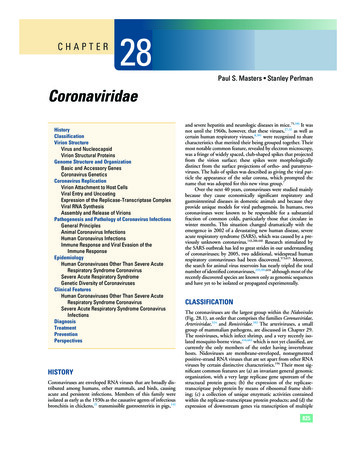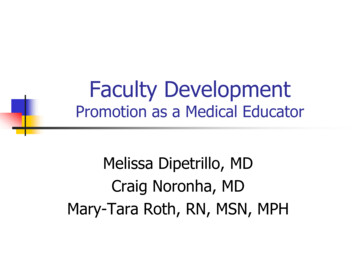
Transcription
Faculty DevelopmentPromotion as a Medical EducatorMelissa Dipetrillo, MDCraig Noronha, MDMary-Tara Roth, RN, MSN, MPH
Faculty development: Med EdPortal SubmissionsMelissa DiPetrillo, M.D.Assistant Professor of MedicineAssociate Clerkship Director Medicine 1Boston University School of Medicine
Med Ed Portal Online resource.Allows for open exchange of peer reviewededucational materials. Provided by AAMC. https://www.mededportal.org/
A little about our project . A Multi Modal Strategy for Teaching thePulmonary Bedside Exam to Third YearMedicine Students.Melissa DiPetrillo M.D.Christine Phillips M.D.Winnie Suen M.DAllan Walkey M.DWarren Hershman M.D.
A Multi Modal Strategy for Teaching the PulmonaryBedside Exam to Third Year Medicine Students. Case based one hour long lecture at the start of Medicine 1. Weekly inpatient bedside teaching with groups of 3-5 students and onefaculty advisor. SOCs (Structured Observation Cards) for feedback review. Feedback forms on the case based lecture.Pre Post likert scale knowledge base test.Pre Post likert confidence based test.Pre test week one of the rotation during Medicine 1 orientation beforethe pulmonary lecture. Post tests last week (week 7 or 8) of therotation.
Med Ed Portal Submission1.Facilitators’ Guide2.Educational Work
Facilitators’ Guide Learning ObjectivesIntroduction: Literature review supporting why youreducational work is important Curriculum logistics Pilot information References
Learning Objectives Clear Learning Objectives 3 to 4 keep concise/ brief Directed at the learner
Learning ObjectivesAt the end of the Medicine 1 rotation thestudent will be able to:(1) Demonstrate a complete and accurate pulmonary exam and use the exam todetermine whether the patient has an underlying pulmonary condition.(2) Identify and interpret abnormal pulmonary exam findings and how they areassociated with the pulmonary disease states: asthma, consolidation/pneumonia, pleural effusion, interstitial fibrosis and chronic obstructivepulmonary disease.(3) Use the tools of the history /physical exam and interpret pertinentdiagnostics, in particular chest xrays and ABGs, to determine whether thepatient has an underlying pulmonary condition.(4) Understand the definition of a likelihood ratio and develop a sense oflikelihood ratios for abnormal pulmonary findings and pulmonary disease states.
Introduction Literature review that helps supportwhy your work is important.
Excerpt: Example Third year students express lack of confidence in bedside examskills. (Reference 6).Recent data regarding actual time spent teaching at the bedsideduring attending rounds are lacking. One study reported thatless than one physical exam skill was taught per day on rounds.(Reference 15).There needs to be a standard, consistent approach to teachbedside skills to students. Bedside exam teaching during theinpatient medicine rotation seems to be an obvious resource toaide in student development of physical exam skills.
Excerpt: Barriers Major categories of barriers include student, teacher, patient and systems issues. Student issues include poor student motivation and confidence. Teacher concerns include environmental time constraints given their clinical duties, lack ofincentive, and lack of dedicated teaching time without page interruptions or patient visitors. System issues include the lack of bedside teaching as the mainstay of education for thirdyear clerks. (Reference 6). Patient related barriers include concerns about privacy and sharing their story in a groupsetting. (Reference 3). Studies have shown that students are not satisfied with bedside teaching rounds because oflack of individual attention provided. (Reference 4).
Curriculum Logistics Case based lecture. (In brief as thisPowerPoint was submitted as oureducational materials). Bedside teaching sessions. Observation cards.
Pilot Information Pre Post Testing
Pre Post Testing Advise IRB approval.Needed especially if you want to matchstudents with their pre post test.Allows for more options with statisticalanalysis.
Pre Post Testing Likert scaleCan use multiple questions and see what yieldsstatistical significanceExample: Confidence in knowledge Confidence in ability to teach Confidence in ability to perform the exam
Description of Pre Post Testing Pre /Post intervention bedside skill confidence based survey.Pre/Post multiple choice, 6 item test that focuses on associationof abnormal pulmonary exam findings with specific diseasestates. Pre tests collected during orientation week 1. Post tests during week 7-8 of the rotation. **Pre / post tests were not linked on an individual student basisbut rather collected per medicine block.
Pre /Post Knowledge Based Test(1) What pulmonary disease state is associated with increased fremitus,egophony, bronchophony and whispered )Pleural effusion(d) Chronic obstructive pulmonary disease(2) Which consolidation/ PNA exam finding has the highest likelihoodratio?(a) Egophony(b) Decreased tactile fremitus(c) Bronchial breath sounds(d) Dullness to percussion
Pre/Post Confidence Based Test(1) Estimate how many times thus far in your medical school experience youhave had the opportunity to perform a pulmonary exam on an individual/patient.For the remaining questions please circle the most appropriatenumber (1 Strongly Disagree, 5 Strongly Agree)(2) I have had a lot of opportunities to practice/ perform the pulmonary exam.12345(3) I am confident in my ability to perform a systematic pulmonary exam.12345(4) I am confident in my ability to recognize an abnormal pulmonary lung sound.12345
Feedback FormFor the first 3 questions, please circle the most appropriate number(1 Strongly Disagree ----5 Strongly Agree)The content of this seminar was relevant to my learning needs12345The format of this seminar was relevant to my learning needs12345The instructors’ presentation and facilitation enhanced my learning.12345Please rate the value of these seminars to your learning.(1 Not at all helpful----5 Extremely Valuable)12345
Some supportive data 118 out of 157 students answered thepre test knowledge based survey;80/157 students answered the post testquestions.The mean pre-and post- test scoreswere 48% and 75% respectively.
“I am confident in my ability to use the pulmonary exam torecognize the presence of an abnormal pulmonary disease statecondition.”Left: Pre Test / Right: Post TestPost Test: Confidence in Interpreting the Pulmonary Exam707060605050Percentage of StudentsPercentage of StudentsPre Test: Confidence in Interpreting the Pulmonary Exam4040Series13020Series1302010100Strongly Disagree23Rate of Confidence Likert Scale4Strongly Agree0Strongly Disagree23Rate of Confidence Likert Scale4Strongly Agree
Educational Material Learning objectives5 cases highlighting disease states: Asthma, ChronicObstructive Pulmonary Disease, Consolidation, PleuralEffusion and Fibrosis.Website copy right to allow play back of abnormalpulmonary sounds during the lecture.Multiple choice questions reflecting the knowledgebased questions on pre post test embedded in thelecture to encourage student participation.
Lecture based PowerPoint Some notations but not scripted.Standardize periods /bullets/font etc.Copy right. Email permission acceptable--very convenient!Before submission asked Winnie Suen M.Dwho had submitted to Med Ed Portal in pastand Allan Walkey M.D. in pulmonarydepartment to look over our material.
Review Process Very Helpful. Very supportive. Very enthusiastic.Targeted to generalized3 reviewersEmail feedbackResubmission by set dateExamples:Combine learning objective one and twoDiscuss/site the following relevant article
Why consider Med Ed Portal ? More consideration now being given to MedEd Portal in terms of promotion.Although looking for pattern of submissions.Single submissions likely not as helpful.Probably already doing something that isscholarly work and just need to tweak andsubmit!
References1. Bates' Guide to Physical Examination & History Taking 9th Edition2. J Gen Intern Med. 2002 August; 17(8): 647–650. doi: 10.1046/j.1525-1497.2002.10750.x3. The Rational Clinical Examination: Does This Patient have a Pleural Effusion? Camilla L. Wong, Jayna Holroyd-Leduc, Sharon E. Straus JAMA.2009;301(3):309-doi:10.1001/jama.2008.9374. The Rational Clinical Examination Does This Patient Have Clubbing? Kathryn A. Myers, MD, EdM, FRCPC; Donald R. E. Farquhar, MD, SM, FRCPC JAMA.2001;286(3):341-347. doi: 10.1001/jama.286.3.3415. Crackles: recording, analysis and clinical significance Eur Respir J, 1995, 8, 2139-2148 DOI: 10.1183/09031936.95.081221396. Steven McGee Evidence Based Physical Diagnosis 2nd Edition 2007Website resources:7. Arcot J. Chandrasekhar, MD, FRCP, FACP, /cxr f.htm8. A Practical Guide to Clinical Medicine Charlie Goldberg, M.D., UCSD School of Medicine and VA Medical Center, San Diego, CA9. www.stethographics.com/main/physiology ls introduction.html10. www.cvmbs.colostate.edu/clinsci/callan/breath sounds.htm11.Accuaracy of Hisotry,Whezing abd Forced Expiraotry Time in the Diagnosis of Chronic Obstructive Oulmonary Disease. Sharon E. Straus et alJGIM:2002:17:684-68812. The accuracy of patient history, wheezing, and laryngeal measurements in diagnosing obstructive airway disease. CARE-COAD1 Group. Clinical Assessmentof the Reliability of the Examination-Chronic Obstructive Airways Disease. Sharon E. Straus et al. JAMA:200:14: 1853-7
Faculty Development:Educational WorkshopsCraig Noronha, MDAssistant Professor of MedicineAssociate Program DirectorInternal Medicine Residency ProgramBoston University School of Medicine
What is a WorkshopA set of activities designed to promotelearning, discussion, and feedback abouta topic or eventSeminar emphasizing free discussion,exchange of ideas, and demonstration ofmethods of practical application of skillsand principles
Where?Local, Regional, and National MeetingsLocal- John McCahan Educational dayRegional- SGIM/ACPNational- SGIM, Academic alliance forinternal medicine, AAMC
Why Do Workshops
Why Do Workshops The particular subject is important to you Get to know people outside of BMC/BUSM It can be a stepping stone to other scholarlyworkPromotion
BenefitsWay to take local work and disseminate itregionally/nationallyCollaboration with other experts in yourarea of interest from around the countryDevelop a national reputation
PromotionTeachingTeaching EvaluationsCould be considered scholarly workPeer review process and evaluation process
Workshop vs PublicationLittle up‐front work, 2 hours to formulatea workshop overview/abstractOnce accepted, development takes about20-30 hours of time, split amongstmultiple participants (usually 3‐5)
Workshop vs PublicationOften less data needed than for apublicationWorks in progress with preliminary dataDepending on the topic- NO DATARequired
Why do people go toWorkshops?
Why do people go toWorkshops?They want interactive and high yield subjectsthat they are interested inJob RequirementYou can ask questions vs large group lecturesNetworking
What do the conferenceorganizers want?Consider hot topics, flavor of the month,conference themesExamples:Value Based CareApps/HIT/social mediaNAS: Milestones and EvaluationWellnessMedical Home
What to presentClinical area of interest– management of abnormal pap tests, how to perform a procedure (joint injection)Resident/med student related– behavioral‐based interviewing, dealing with the problem learner, 3 1 scheduling,teaching physical exam skillsMethods- designing a curriculum, research methods in medical education researchProfessional development-how to be an effective mentor/mentee, work life balance,How you do it- Use of Apps in education, Resident patient hand offs,
Examples of Workshops Teaching Clinical Reasoning (WarrenHershman)Guidance for Personal Letters ofRecommendationsBreaking Away from the Ipatient toCare for the Real PatientUrine drug testing in primary caresettings: Practical considerations forclinicians and educators (JaneLiebschutz)
Who to work withWithin institution others with similar interests or areas of expertise**Consider including those at different stages of their careersFellows, senior educators, new hires, chief residents**Multi‐institutional-Colleagues you have worked with before-National experts in given area-Interest group or other subgroup of a national association in yourfield-List serve connections-People you meet at other workshops
StructureDidactic component– Powerpoint slides vs. handouts vs. both– Give participants basic information about topicInteractive component- MOSTIMPORTANT- Case‐based format- Small group discussions- Learning or skills stations- Facilitated question/answer sessions
Time BreakdownDidactic 20%Interactive 60%Questions and Answers 15%Evaluations 5%
Abstract SubmissionConsult the submission guidelinesInclude background information of why topic isimportant to prospective audienceTell them what to expect: what will happenTell them what they will take away- Deliverableshandouts, post-workshop emails, Flash drives
Learning ObjectivesSummarize what will the participant willbeable to do after attending the workshop.Use Blooms Taxonomy to maximizeACTION words
Accepted vs notWell written abstract?Deliverables?How many other submissions were similar toyours?Did it fall within goals/themes identified byconference organizers?
After careful review of the proposals, the APDIM ProgramPlanning Committee decided not to accept “Teaching residentsabout Professionalism in EMR use.yes that is our job to,” forinclusion in the 2014 APDIM Spring Meeting. However, APDIMencourages you to submit a workshop again in the future.The program plan
Why consider Med Ed Portal ? More consideration now being given to Med Ed Portal in terms of promotion. Although looking for pattern of submissions. Single submissions likely not as helpful. Probably already doing something that is scholarly work and just need to tweak and submit!
